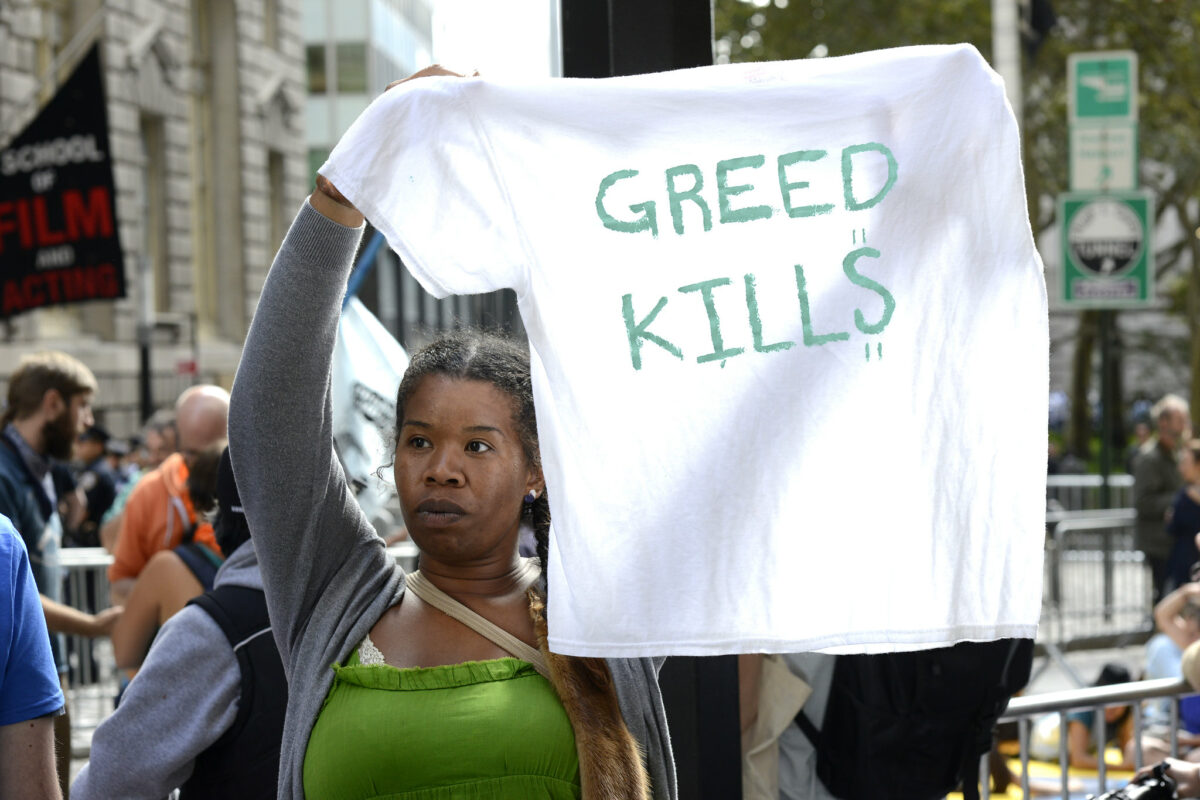You could be forgiven for thinking that Wall Street has experienced a climate epiphany. Bank of America brags about its environmental credentials; Citigroup’s new CEO announces on her first day that achieving net-zero emissions is a top priority. The onslaught has convinced many in even the left-leaning media that Wall Street will lead the way to a better, greener version of capitalism.
Unfortunately, if you look beyond the green veneer, you’ll find a different story. In 2021, JPMorgan Chase provided $61.7 billion in financing to the fossil fuel industry, Citigroup loaned $15.1 billion to the corporations most rapidly expanding their oil and gas operations, Wells Fargo and Bank of America provided the fracking industry with $12.9 billion.
In May 2021, the IEA, the world’s most respected energy modeler, announced that to have a fifty percent chance of limiting global warming to 1.5°C, there can be no new oil and gas fields developed. Yet, within three months of the IEA’s announcement, Citi, Chase, Bank of America, and Morgan Stanley helped facilitate $36 billion in financing to the corporations most rapidly opening new oil and gas fields, including Exxon-Mobil, Aramco, and BP.
But let’s pause here. Maybe we’re being unfair. Leading climate scientist, James Hansen, may have testified to Congress in 1988 that global warming required urgent action, but banks have only recently promised to act on climate. Maybe we shouldn’t judge them on what they did last year, but on what they say they’re going to do in the years ahead. Fortunately, as the largest banks have all now set 2030 climate targets, we’re able to do that. Unfortunately, this is where banks’ climate pledges turn from bad to ugly.
Four of the largest US banks—Chase, Bank of America, Morgan Stanley, and Goldman Sachs—have set 2030 climate targets for the fossil fuel sector using a metric known as “carbon intensity,” pledging they will achieve anywhere between a fifteen percent and twenty-nine percent reduction in the “carbon intensity” of the oil and gas firms they finance.
The thing to know here is that reductions in “carbon intensity” and reductions in “actual greenhouse gas emissions” are not the same thing.
Imagine you are the CEO of an oil firm. Your company owns 500 oil wells; it doesn’t own any gas fields. Chase gives you a $1 billion loan. You use that loan to buy 50 new oil wells and open a new gas field that you intend to frack. You now own 50 oil wells and a fracking operation. Your overall contributions to climate change have gone up significantly. Yet, because gas is often considered to be less carbon-intensive than oil (a fatal mistake, when we consider methane leakage from gas operations) by Wall Street’s reckoning the “carbon intensity” of your company has gone down.
Chase, Bank of America, Morgan Stanley, and Goldman Sachs have set 2030 climate targets that they will be able to hit even as their emissions increase.
Only two of the major US banks have avoided the carbon intensity boondoggle and set “absolute emissions reduction” targets: Citi and Wells Fargo. Of those, only Citi has stated that it’s considering ending financing for fossil fuel clients—and only then, will it be done as a “last resort.” Given that oil and gas majors spent $70 billion on developing new oil and gas fields in 2021, quite how Citi and Wells Fargo think they can hit their climate targets without letting go of corporations expanding their fossil fuel operations is unclear.
Given the long history of rapacious greed on Wall Street, it may be that Wall Street CEOs simply don’t care about reigning in the climate crisis. There are things that they care about though. Namely, their brand and their customers. That’s why it’s heartening that so many are now calling out Wall Street’s role in the climate crisis.
Since the Stop the Money Pipeline coalition launched two years ago, it has grown from a coalition of some thirty organizations to one of over two hundred climate, environmental, Indigenous rights and racial justice groups. This AGM season, there were disruptive protests at the shareholder meetings of Citi, Wells Fargo, Bank of America, and Chase. Days before Citi’s AGM an activist’s bird dog of the bank’s sustainability manager was viewed by hundreds of thousands of people across social media. This kind of tireless organizing represents a brand risk to the banks, which is something they care deeply about. They also care about their customers.
Since April, more than 38,000 customers of Chase, Citi, Wells Fargo, and Bank of America have joined a campaign called Customers for Climate Justice, demanding their bank stops financing fossil fuels. Many more have signed Third Act’s Banking on our Future Pledge, promising to cut up their credit cards and move banks if they don’t. If you bank at one of the world’s largest funders of fossil fuels, you should join these campaigns.
For this may be the only good thing about Wall Street’s empty climate promises. We can do something about them.
